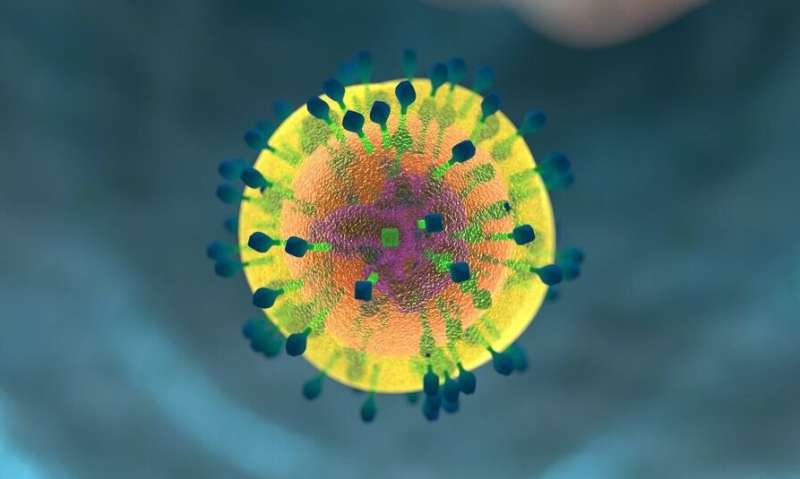This article has been reviewed according to Science X's editorial process and policies. Editors have highlighted the following attributes while ensuring the content's credibility:
fact-checked
peer-reviewed publication
trusted source
proofread
How 'late-rising' T cells combat a stubborn virus

Cytomegalovirus (CMV) is a pathogen that likes to lurk. Most adults already carry CMV, and they show no symptoms at all. The trouble comes when the virus infects a pregnant person for the first time and passes through the placenta. Babies born with congenital CMV can develop deafness and life-long health problems.
"CMV is the number one infectious cause of birth defects," says Chris Benedict, Ph.D., Associate Professor at La Jolla Institute for Immunology (LJI) and member of LJI's Center for Vaccine Innovation. "That's why there's such a push to develop a vaccine against this virus."
Benedict and his colleagues are investigating how the body's immune cells combat CMV infection. Their latest study, "Late-rising CD4 T cells resolve mouse cytomegalovirus persistent replication in the salivary gland," published in PLOS Pathogens, reveals how a subset of CD4+ "helper" T cells may help a person fight CMV and reduce the chances of the virus spreading from person to person.
"We found sort of a special 'flavor' of CD4+ T cells critical for clearing this chronic virus replication," says Benedict.
This research was conducted in mice, and the scientists say the next step is to identify similar cells in humans. "We now have the footprint of these cells and can say, 'here is the type of cell we'd want to induce through a vaccine approach," says Benedict.
The key to stopping CMV infection
CMV usually spreads through exposure to contaminated saliva or urine. It's common for people to pick up the virus during childhood. Once infected, some people experience mild cold symptoms before the virus seems to vanish.
But the virus isn't gone. Instead, it has merely begun its replication phase, where it churns out many, many copies of itself. Even if a person appears healthy, they can still pass along the virus for a long time after infection.
"If you have a baby and they are infected with CMV at a very young age, or in the womb, then they could shed CMV in their urine for the next year at very high levels," says Benedict. "Which is why, for instance, almost 100 percent of daycare workers in this country are infected with CMV—because they're constantly in contact with fluids from young kids who could be shedding CMV."
After this long replication phase, CMV goes into hiding in the body. As Benedict explains, CMV belongs to the herpes virus family—a viral family famous for having long "latency," or inactive, periods.
The new findings show how scientists might interrupt the replication phase to stop a person from shedding CMV much, much sooner.
What makes these T cells special?
When you catch a virus, many different types of T cells jump into action to help combat severe infection. Within just a few days of infection, T cells are busy destroying infected cells, controlling inflammation, and recruiting B cells for the battle. Most of these T cells then fall back once they think the battle is won.
"Virtually all T cell populations expand during the first week of infection and then contract—they lose about 90 percent of their numbers," says Benedict.
For the new study, the researchers used a technique called flow cytometry to identify subsets of T cells that fight CMV at different points in the infection timeline. This analysis, performed with samples from a mouse model of CMV infection, revealed a unique group of CD4+ "helper" T cells that arises around 40 days after infection.
These late-rising T cells expand long after the initial T cell response has died down. Interestingly, these T cells gather in very high numbers in the salivary gland—a hub of CMV replication and key source of viral transmission.
LJI Postdoctoral Fellow Simon Brunel, Ph.D., led the work to understand what these late-rising T cells are doing in the salivary gland. Using a method called RNA-seq, Brunel found that these cells express powerful antiviral immune molecules called IFNg and IL-2.
"We can start to see what makes these cells so special—how they protect the body and reduce the amount of CMV in salivary fluid," says Brunel.
Benedict and Brunel say more work needs to be done to understand exactly how these cells function—and to find them in humans. The new study gives them hope that a future CMV vaccine or therapeutic can induce a strong response from this type of T cell and reduce the odds of a person spreading CMV.
More information: imon Brunel et al, Late-rising CD4 T cells resolve mouse cytomegalovirus persistent replication in the salivary gland, PLOS Pathogens (2024). DOI: 10.1371/journal.ppat.1011852


















